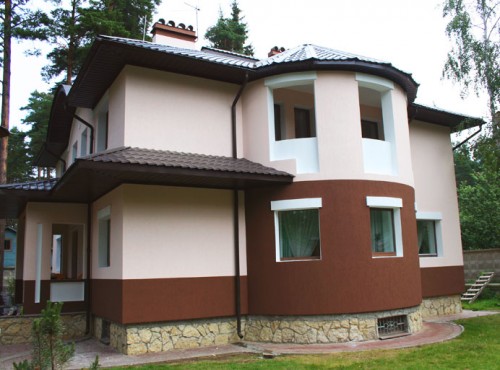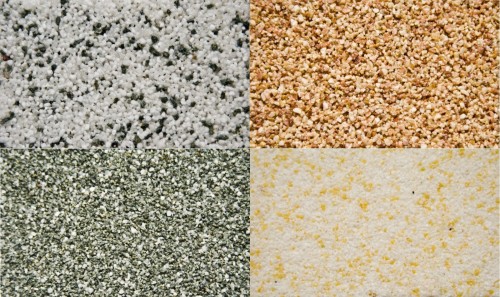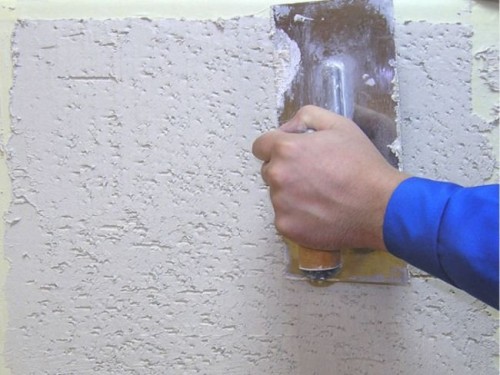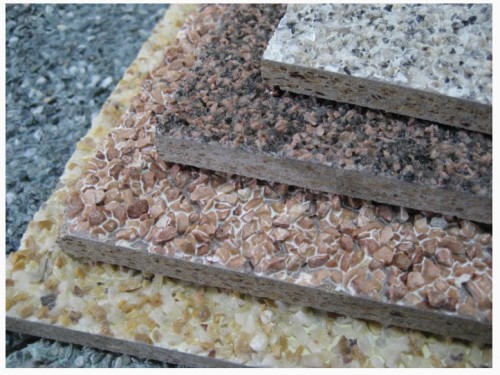The trim of the facade of the house of the plaster is a common phenomenon. There are several reasons for this: the material has a fairly acceptable value, but the diversity of its colors and methods of application makes it possible to show fantasy and make a dwelling with beautiful and original. In this article we will talk about the main features of the facade plaster and the rules of its use in practice.
Distinctive properties of material
The main requirements for the outdoor coating of the house is its reliability and attractiveness. Facade plaster is able to satisfy these conditions due to its following qualities:
- Waterproof. Thanks to this property, the building is not injured under the influence of snow, rains and other precipitation. In addition, the material protects the dwelling from the penetration of moisture inside the walls.
- Temperature stability. This feature is a large plus for buildings located in areas with a large difference between seasonal temperatures. This quality will not allow plaster to suffer from a strong cold or heat and lose its beautiful decorative look.
- Rigidity. Such material easily withstands various impacts and mechanical load.
- Parry permeability. Such ability does not cover the coating, air and certain humidity are freely circulated through the layer of plaster, allowing the material to maintain its original structure.
- Sound and temperature isolation. The application of a layer of this material on the outer surface of the walls makes the dwelling more warm, and also limits the penetration of unnecessary noise into the room.
- Color and textural variety. The finishing of facades of private houses by plaster allows you to show fantasy and make the design original and original. You can experiment not only with the gamut of shades, but also with textures, and special stencils will help to apply any pattern on the wall.
- Easy work. You can make facing the building as much as possible. To do this, you only need to arm yourself with the necessary tools and some knowledge.
- The price of the facade of the house of the plaster will not be too high, so this option is acceptable for many. It is necessary to add that the cost of the coating can vary under certain limits, depending on the variety of the mixture and manufacturer's company.
Types of material
Most often, such coating varieties are used to cladding homes:
- silicone facade plaster;
- acrylic facade plaster;
- cement-sand mix;
- decorative plaster.
Consider more details the main properties of each of the materials:
- Silicone coating is a polymer mixture that is made from silicone resin. The main advantages of such a composition are: moisture resistance, the ability to withstand temperature differences and exposure to sun rays, long service life. If you want the appearance of the construction of the presenter for a long time, the silicone plaster is your option. It should be added that it will cost that the coating will be quite expensive, but it will not last one year.
- Acrylic mixture is one of the most budgetary types of coating. It is often used to apply over polystyoltol, which the house is insulated. The advantages of such a composition can be considered hydrophobicity and elasticity, and the minuses are insufficient vapor permeability and the ability to quickly pollute.
- Cement-sand coatings are mixtures of sand, cement and a variety of additives. Such plaster can be used in areas where there are large temperature differences or frequent elevated air humidity.
- Decorative coating gives the greatest space for the flight of designer thought. The trim of the facade of the house with decorative plaster makes it possible to implement many ideas, giving the structure a beautiful and unusual look. With the help of such a cladding, you can create a imitation of a variety of surfaces.
Technology of work
It is possible to carry out the coating on the wall independently, this will require the presence of standard tools for shockting. In the event that you want to create an unusual relief or pattern, you will also need some special skills that you can purchase, while practicing a little.
Consider more a sequence of actions when finishing the facade of the house by plaster:
- First of all, it is necessary to prepare the surface of the wall, for this you need to clean it from dust and other contaminants. If the house was previously decorated with other materials, they must be removed, and the wall is to clean. All convexities and depressions on the surface must be aligned using putty. Remember that work should be carried out in good weather, without wind and rain, at air temperature from +5 to +27 ° C. In a strong heat, moisture from the plaster will evaporate too intensively, because of which cracks may appear on the surface.
- The second stage is the creation of the reinforcing layer. To do this, you will need to make a glue solution and leave it in line for 7-10 minutes. Cover the wall with this composition and glue a layer of special glass equipment. After everything is driving, apply a layer of acrylic primer. The trim of the facade of a wooden house with plaster involves the mandatory presence of a crate, which will not allow moisture from the coating to penetrate the wood.
- The next step is to make a solution of plaster. As a rule, the proportions of the mixture can be found on the package with the material. If the plaster turns out too thick, do not be afraid to add some water.
- The most responsible part of the work is to coating on the wall. By this time you need to accurately determine how you want to see the future surface structure. From your chosen option will depend on the application technology and a set of toolkit. The first layer of plaster is called spraying, it is necessary to be made as smooth as much as possible and quite thin. Remember that each of the levels of the coating should not be thicker 4 cm. Make the application of the next layer only after the previous one will finally dry. Laying the solution is done manually or with a special typewriter. The second option will cost more, but it will reduce the time of work.
- Pushing the surface. This process is performed when the plaster dried, but not until the end. If you plan to create an unusual texture, it is necessary to do this at this stage using special rollers.
Facade Walking Tips
In order to work smoothly, and the result served for many years, some subtleties should be taken into account:
- It is possible to produce the process of plastering a new structure only after its complete precipitation.
- All stone work should be completed before you start coating.
- So that the decorative effect was not sacrificed with flaws, to the processing of the problem areas of the facade, for example, complex geometric forms, can be attracted by specialists in this area.
- Do not save on the quality of plaster. Choose tested brands and manufacturers that have proven themselves in the building materials market.
- For decoration of stone walls, lime-sandy mixes are more suitable, when using a coating on wooden surfaces, some plaster can be added to the composition of such plaster.
- To increase the thermal insulating ability of the material, part of the slag sand or other suitable filler should be added to the mixture.
Finish facade house plaster, video:


















 Start a discussion ...
Start a discussion ...